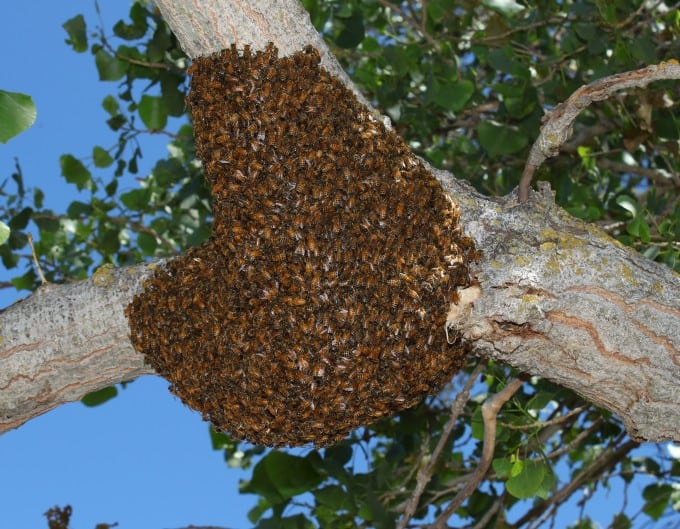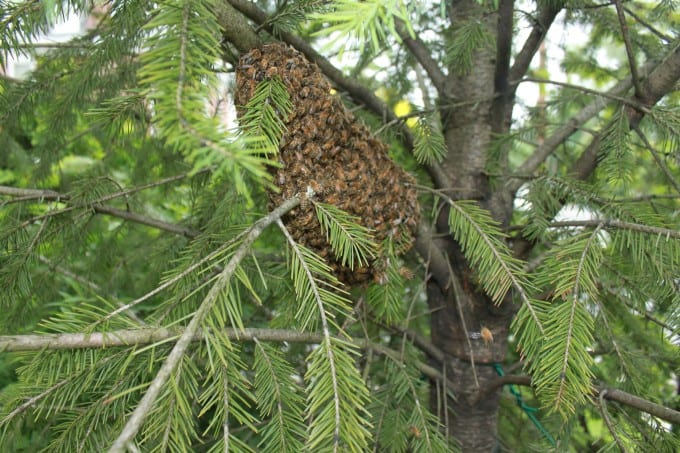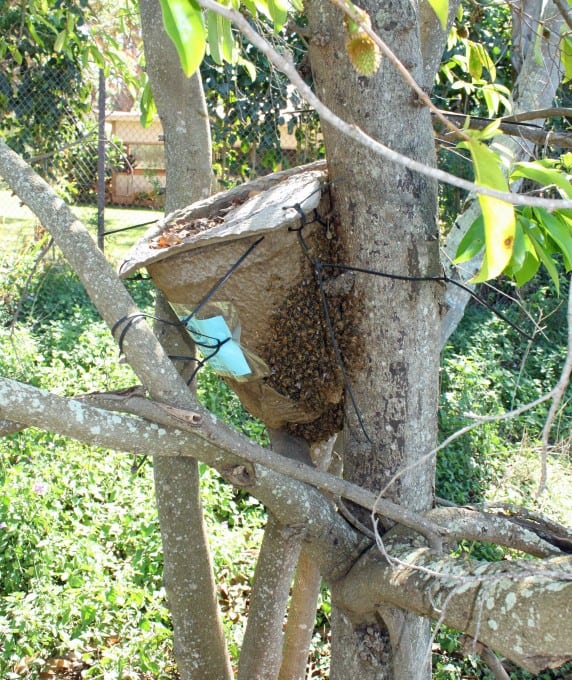
When someone informs you of a swarm, it is critical that you ask some important questions and take down some information before heading out to catch it. These important items include the following:
• You need to know the height of the swarm to determine if you can reach it by standing or if a ladder will be required.
• It is also important to determine that they are actual honey bees; the best way to do this is ask questions. Many calls come in but in fact, are for wasp nests or some other insect.
• Are they on a branch you can cut or on another object where you may need to extract them?
• It is good to know how long they have been there as they usually don’t stick around too long and it’s important to catch the swarm quickly. If the swarm has been there several days you may need to move quickly and it is important to identify the queen.
Items needed to collect a swarm:
-Box with openings. If the box is made from cardboard, make sure it is fully taped on the bottom.
-Protective clothing (at least a veil)
-Pruning shears and a pruning saw
-Stick to be placed on a diagonal in the box for bees to hold onto
-Spray bottle filled with sugar syrup
-An old bed sheet or towel to seal the box
-Two or more bungee cords
-Bee Vacuum if extracting
Now that you have what is needed to collect the swarm, you must prepare the apiary you are placing the swarm into and it is best to do this before capturing the swarm. Set up the hive like you are getting a package. I pull 5 or more frames out of a 10 frame hive body so there is space for the bees. Now, back to catching the swarm.
Once you get to the location of the swarm, you can better assess the situation. If the swarm is localized around many branches it is best to uses the pruning shears and saw to remove branches so the swarm will fit into a box you have brought. In some cases you may need a larger box. It is best to spray the bees lightly with sugar syrup; this will keep them busy and out of your way while you trim branches. Once you clear the area and have easy access to cut the main branch the swarm is on, spray the bees again lightly and get the box ready. I usually spray the inside of the box a few times with the sugar water to keep them busy while inside the box. Do not spray the syrup heavily onto the bees or they will stick together and you will have a big mess! When the branch is cut you can now place the branch on a diagonal inside the box, this is important to keep the bees from flying all over the place. Once you have situated the branch inside the box you can place the sheet or towel over the box and use the bungee cords to hold the sheet or towel onto the top of the box. This allows for ventilation. If you are not sure that you have caught the queen, you can partially cover the top and wait for an hour or two to see if the remaining bees are making their way into your box. If they are, you have captured the queen. In the top photo, there was easy removal of the swarm since it was held by only one part of the tree. In the image below you can see a swarm where it was more work to trim the area of branches before a clean removal was possible. There is another image below with the branch and swarm inside the box before placing the cover on.

If the colony is situated like the once pictured below, it is pretty easy. You spray the bees a little bit more aggressively with the sugar syrup and then use the bee brush to sweep them into the box. The only difference is here you would place a stick or stick like object in the box on a diagonal to give the bees something to hold onto. This also makes it easier to shake the bees into your hive later.

I have not provided details about extraction of bee colonies from homes, roofs, sidings, chimneys or other manmade structures. Visit Website to get the best siding work done for your home. In most cases, these take a day or two and can be very tedious and involve using a bee vacuum. There are a few different videos of home extractions on the internet that can show you some of the basics on extracting colonies from these structures.

When you are placing the swarm into your equipment it is best to remove a few frames to allow for the space of the swarm as mentioned above in getting your apiary ready. You can go back a few hours later to add the other frames back to the hive. It is best to put the bees on to foundation as swarms are great at drawing out wax in a new space. Spray the inside of the hive and the frames with sugar syrup before installing the bees. I will also put a frame of sealed and unsealed brood, two empty frames and one frame of honey in with newly captured swarms. This prevents the bees from absconding, but allows for possible contaminants. Other people will put queen excluders below the bottom hive body to prevent absconding until they are established. Once the colony is established with brood it is safe to take out the excluder. It is important to feed swarms sugar syrup, this also helps prevents absconding and promotes build-up. Below are some other pictures from swarms and a feral colony.


